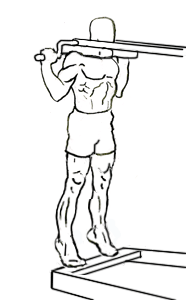- You are here:
- Home »
- Blog »
- Training »
- What muscles do calf raises work?
What muscles do calf raises work?

Demonstration of a Standing Calf Raise Machine – Photo By: Wikimedia
It’s in the name, right?
Heel or calf raises, either seated or standing, are a common lower body exercise and a good finisher to a complete leg workout. But exactly what muscles do calf raises work out?
Muscles directly worked – gastrocnemius, soleus, tibialis posterior
The calf muscle group is made up of two muscles – the gastrocnemius and the soleus. The gastrocnemius is the large diamond shaped muscle at the top of the calf, while the soleus is the small muscle that goes underneath it.
The description of the muscles, according to WebMD, is that the gastrocnemius is “the larger calf muscle, forming the bulge visible beneath the skin. The gastrocnemius has two parts or “heads”, which together create its diamond shape.” The soleus is “a smaller, flat muscle that lies underneath the gastrocnemius muscle.”
The tibialis posterior is located “in the deep posterior compartment of the leg. It is the key stabilizing muscle of the lower leg”, according to Wikipedia.
Related: 5 Best Standing or Seated Calf Raise Alternatives
There are 2 main types of heel or calf raises – seated and standing. Using proper technique is important to get the most out of the exercise no matter what version you are doing.
Seated Calf Raise Machine
The video below demonstrates proper technique for calf raises on a seated machine. You begin by sitting on the bench pad with good posture and a strong core. Put the balls of your feet on the foot pad and adjust the height of the knee pad to your desired height.
You then press up with your calves to lift up the knee pad and then unlock it. You then perform your desired number of reps with a full range of motion and make sure to lock the pad back into place when you are finished.
You can perform these with 1 or 2 legs if your machine allows it. Make sure you have the right kind of machine if you are perform the single legged version of this exercise, otherwise you might not be able to balance it. If you don’t have a machine, you can perform this with a barbell on top of your legs. It is much trickier, but doable if you are experienced and safe.
Standing Calf Raise Machine
You can see what good form for standing calf raises on a machine looks like in the video below. You put the balls of the feet on the foot platform and get under the shoulder pads, as if you are beginning a squat. You then stand up with the weight and unlock the machine.
You then perform the desired number of calf raises, using good technique and a full range of motion. Then, return the upper body rests to the starting position and lock it back into place.
These can also be performed with 1 or 2 legs. If you don’t have a machine, a Smith machine or regular barbell in a squat rack are commonly used. In this scenario, it helps if you have a small, stable block to put the balls of your feet on when performing reps. This version is very difficult to balance if you are using free weights. Doing a free weight version with 1 leg isn’t recommended as it is very challenging to balance.
The muscles are worked very similarly whether you are doing the seated or standing version. You can vary your stance between sets to target the muscles differently.
A standard calf raise, with your toes pointed forward, will primarily work the big gastrocnemius muscle. As this is the biggest and main muscle in the calf, it will be worked pretty much no matter how you do them.
However, if you move your heels out and your toes together, the tibialis posterior will be worked more. A setup like that will target the interior muscles of your calves better. The soleus muscle will also be worked pretty evenly no matter what, as it is the stabilizing muscle that is underneath the others.
The calf muscles are an important body part if you are looking to add overall size and strength to your legs. It is important to work the different muscles in the calves evenly to get a balanced look and functionality.

